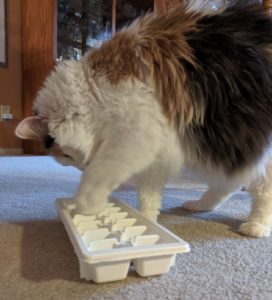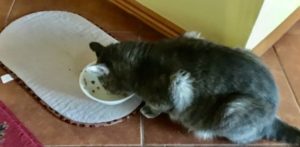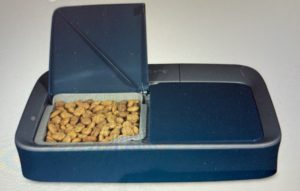How to Feed Your Cat
Your cat has evolved to eat a diet rich in protein found in meat. His stomach is small (said to be the size of a ping pong ball but clearly must stretch – when a cat eats a mouse, he will eat the whole thing, tail included).
In the feral cat colony…
- cats hunt during the late afternoon to early morning hours
- they sleep during most of the daylight hours.
- A feral cat has about 3 hunting sessions – late afternoon, midnight and early morning
- he probably eats about 6 mice a day (it takes 3-4 hours for his stomach to empty)
- most of his waking hours are spent on the prowl, looking for food.
Hunting is hard work – experts have estimated success rates of less than 50%. When cats moved indoors, they gave up this free-roaming life but small, frequent meals is still the best way for them to eat. You will avoid vomiting due to overeating and food retention in the stomach.
How to Feed Your Cat: free-feed or meal-feed?
Free-Feeding

- your cat eats when and how much she likes
- convenient
- usually kibble (dry food)
Meal Feeding

- feed measured portions of food
- usually at scheduled times of day
- can be canned food
Cons of Free-Feeding
- boredom can give rise to eating as a self-soothing behavior
- kibble is not very filling so your cat eats more
- kibble has a longer transit time in the GI tract
Cons of Meal Feeding
- you feed the dog twice a day – why not the cat?
- portions are often larger than a cat can or wants to eat
- can cause vomiting
- food waste
The Plan: Offering 4 small meals daily
How to feed your cat: here is a plan for the cat guardian who works and is away from home during the day. It combines free-feeding and meal-feeding. If you work at home, you can use this plan with some changes: offer a small meal at the middle of the day; you can combine this with a training session or some play time if you wish.
Foraging Behavior: Daytime
Our feral kitty spends his waking hours prowling around, checking for prey. He will root around in mouse holes and dig and smell for things in the grass. He is not above grabbing an insect snack.
Food Puzzles
- Food puzzles mimic your cat’s natural foraging behavior.
- These puzzles can be moving or stationary.
- Your cat may like rolling treat balls around and snacking on the kibble that falls out of holes in the ball.
- Other puzzles are stationary and your cat will use his paws to get kibble out of the puzzle.
- Some puzzles can accommodate canned food – you can often find a place for a small cool pack in the puzzle if spoilage is a concern.
- Make sure your cat cannot chew the cool pack or ingest it.
Timed Feeders

- Timed feeders are another option.
- Feeders are available that can be programmed and provide up to 5 meals a day.
- Cats quickly figure out when the feeders open and will wait for this.
- To mimic some foraging behavior, get two 2-meal feeders and put each feeder in a different place each day.
- If you have the 2-meal feeders, ice could go in one side if you would like to use canned food and are concerned about spoilage.
Did you know? Dry food stays in our cats’ stomachs longer than canned food. Recent studies showed some dry food in the stomach 8 hours after eating; the moist food was gone by 4 hours.
Like what you see?

